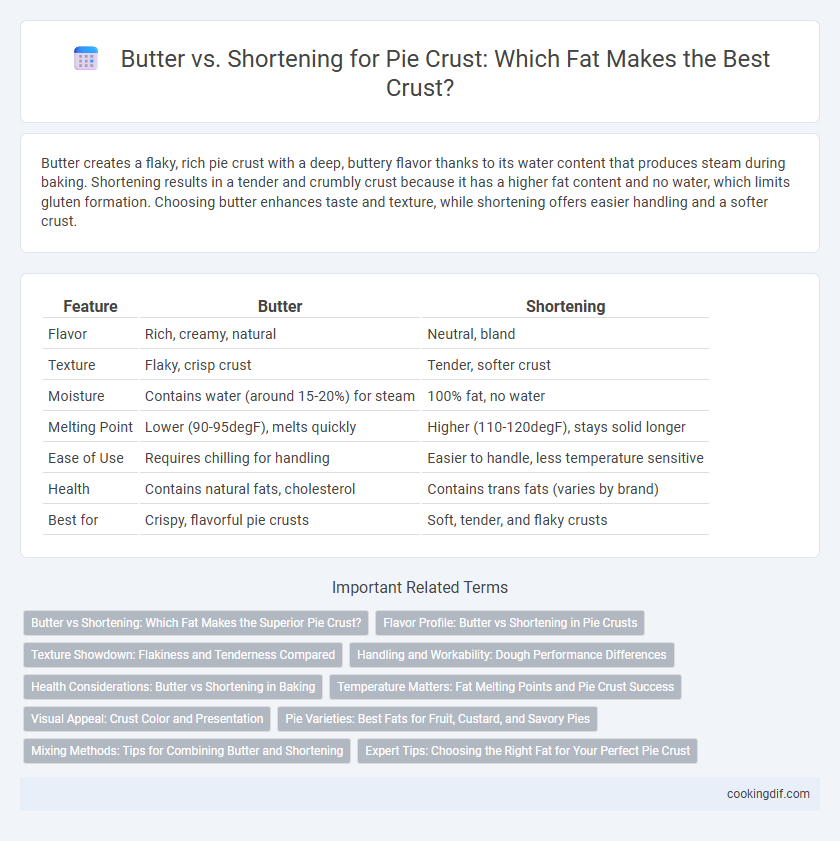Butter creates a flaky, rich pie crust with a deep, buttery flavor thanks to its water content that produces steam during baking. Shortening results in a tender and crumbly crust because it has a higher fat content and no water, which limits gluten formation. Choosing butter enhances taste and texture, while shortening offers easier handling and a softer crust.
Table of Comparison
| Feature | Butter | Shortening |
|---|---|---|
| Flavor | Rich, creamy, natural | Neutral, bland |
| Texture | Flaky, crisp crust | Tender, softer crust |
| Moisture | Contains water (around 15-20%) for steam | 100% fat, no water |
| Melting Point | Lower (90-95degF), melts quickly | Higher (110-120degF), stays solid longer |
| Ease of Use | Requires chilling for handling | Easier to handle, less temperature sensitive |
| Health | Contains natural fats, cholesterol | Contains trans fats (varies by brand) |
| Best for | Crispy, flavorful pie crusts | Soft, tender, and flaky crusts |
Butter vs Shortening: Which Fat Makes the Superior Pie Crust?
Butter delivers rich flavor and a flaky texture due to its water content creating steam during baking, while shortening offers a tender, crumbly crust by coating flour proteins and preventing gluten formation. Choosing butter ensures a golden, flavorful crust with a slight crispness, but shortening provides superior ease in handling and a consistently soft, melt-in-your-mouth bite. For the best pie crust, many bakers combine both fats to balance flavor, texture, and workability.
Flavor Profile: Butter vs Shortening in Pie Crusts
Butter imparts a rich, creamy flavor with natural dairy notes that enhance the overall taste of pie crusts, creating a more indulgent and aromatic experience. Shortening offers a more neutral taste, allowing other pie fillings to stand out while providing a tender, flaky texture due to its higher melting point. Choosing butter enhances flavor complexity, whereas shortening emphasizes texture and stability in pie crusts.
Texture Showdown: Flakiness and Tenderness Compared
Butter creates a pie crust with superior flakiness due to its water content, which evaporates during baking and forms delicate air pockets. Shortening adds tenderness by preventing gluten development, resulting in a softer, more crumbly texture. Combining both can balance flakiness and tenderness, achieving an ideal pie crust texture.
Handling and Workability: Dough Performance Differences
Butter offers superior dough handling due to its natural moisture content, which creates a tender and flaky pie crust as it melts during baking. Shortening provides easier workability by remaining solid at room temperature, making the dough less sticky and simpler to roll out without warming too quickly. The choice between butter and shortening directly impacts dough elasticity, rollability, and overall crust texture in pie preparation.
Health Considerations: Butter vs Shortening in Baking
Butter contains natural saturated fats and provides vitamins A and E, contributing beneficial nutrients but also higher cholesterol levels. Shortening is trans-fat free in modern formulations and offers a neutral flavor with longer shelf life, yet it often lacks vitamins and may contain hydrogenated fats if not labeled trans-fat free. Choosing butter supports more natural ingredients and antioxidants, while shortening may benefit those seeking a consistent texture and longer storage without additional cholesterol.
Temperature Matters: Fat Melting Points and Pie Crust Success
Butter has a lower melting point around 90degF (32degC), which creates a flaky and flavorful pie crust as it melts quickly during baking, releasing steam that forms delicate layers. Shortening melts at a higher temperature near 115degF (46degC), producing a tender, crumbly crust with less spread but often lacks the rich taste of butter. Choosing the right fat with consideration to its melting point is crucial for achieving the desired texture and structural integrity in pie crusts.
Visual Appeal: Crust Color and Presentation
Butter creates a pie crust with a rich golden-brown color due to its natural milk solids caramelizing during baking, resulting in an appealing, glossy finish. Shortening produces a lighter, paler crust that often lacks the attractive golden hue but offers a uniform texture and less flakiness. Visual appeal is enhanced by butter's ability to provide a warm, inviting crust color crucial for a mouthwatering presentation.
Pie Varieties: Best Fats for Fruit, Custard, and Savory Pies
Butter provides rich flavor and a flaky texture ideal for fruit pies, while shortening creates a tender, crumbly crust perfect for custard pies. Savory pies benefit from a blend of butter and shortening, balancing flavor with structure for optimal mouthfeel. Pie crusts made with butter yield aromatic, golden results, whereas shortening maintains superior dough pliability and prevents shrinkage.
Mixing Methods: Tips for Combining Butter and Shortening
Achieving the perfect pie crust texture involves combining butter and shortening with specific mixing methods that balance flakiness and tenderness. Cut cold butter into the flour until pea-sized pieces form, then incorporate shortening to create a cohesive dough that retains moisture while producing a flaky texture. Gently mixing these fats with minimal handling prevents gluten development, ensuring a delicate, buttery crust with superior structure.
Expert Tips: Choosing the Right Fat for Your Perfect Pie Crust
Butter offers a rich flavor and creates a flaky texture due to its water content that steams during baking, while shortening produces a tender, crumbly crust with higher fat content and no water. Experts recommend using a blend of butter and shortening to balance taste and texture, ensuring both flakiness and softness. For an ideal pie crust, chilling the fat and dough before baking enhances flakiness by preventing excessive melting and mixing.
Butter vs Shortening for crust Infographic

 cookingdif.com
cookingdif.com